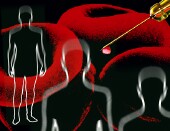
THURSDAY, Nov. 24 (HealthDay News) — Higher doses of chemotherapy with less time between treatments may benefit younger people suffering from aggressive lymphomas, such as diffuse large B-cell lymphoma (one of the most common and aggressive forms of non-Hodgkin’s lymphoma), according to new research.
A study published online Nov. 24 in The Lancet found this intensive form of chemotherapy, when combined with the monoclonal antibody drug rituximab, may reduce recurrence of the disease and increase survival rates among patients under 60 years of age.
The researchers said these younger patients are about twice as likely to remain in remission after three years versus those given rituximab plus the standard chemotherapy treatment known as CHOP (cyclophosphamide, doxorubicin, vincristine, and prednisone).
In conducting the study, researchers led by Dr. Herve Tilly of the University of Rouen in France gave 379 patients with diffuse large B-cell lymphoma either four cycles of higher-intensity chemotherapy (doxorubicin, cyclophosphamide, vindesine, bleomycin, and prednisone) plus rituximab at two-week intervals, or eight cycles of the standard treatment (CHOP plus rituximab) at three-week intervals.
The study found the risk of experiencing an “event-free survival” (which means avoiding unplanned treatments or cancer recurrence) after three years was 44 percent lower among patients on the more intensive regimen than among those receiving standard treatment.
Patients assigned to the aggressive treatment also had a 56 percent lower risk of death and were 52 percent less likely to have their disease progress compared to those on the standard treatment, the researchers found.
There was a downside to the more aggressive approach, however. The study found that the strategy significantly boosted the likelihood that patients would experience serious side effects, particularly negative hematological and mucosal effects, as well as febrile neutropenia (a complication of chemotherapy that involves a reduction in immune white blood cells, accompanied by fever).
For that reason, “this dose-intense regimen should only be used in patients in whom the expected relapse rate is sufficient to justify the higher toxic effects and cost profile,” Julie Vose from the Nebraska Medical Center in Omaha wrote in a journal commentary accompanying the study.
One expert agreed that the regimen’s benefits must be weighed against its risks.
“The results are impressive, but caution should be used while using this regimen,” said Dr. Jasmine Zain, assistant professor in the department of medicine at NYU Langone Medical Center in New York City. She noted that the study was conducted in young patients with a form of lymphoma that already has an “excellent” prognosis. “This regimen should only be considered in a young, healthy patient where the risk of relapse is high enough to warrant a more intensive regimen,” she added.
Another lymphoma specialist said the more intensive approach may prove successful.
“Even though the intensified regimen is associated with more toxicity, there is a significant improvement in survival in this adult population between ages 18 and 60 years of age,” said Dr. Arlene Redner, associate chief of oncology at Steven and Alexandra Cohen Children’s Medical Center of New York, in New Hyde Park, N.Y. “This is a concept that pediatric oncologists have been using and which has been responsible for some of the excellent results that have been seen in pediatric lymphoma trials,” she noted.
The study’s authors stressed that some patients can still relapse even after responding to the more aggressive treatment, and the ideal chemotherapy regimen to combine with rituximab has not yet been established. They add that more research is needed to identify patients who are most likely to benefit from this more intensive treatment.
The study was funded by The Study Group on Adult Lymphomas and drug maker Amgen.
More information
The U.S. Leukemia and Lymphoma Society provides more information on lymphoma.

